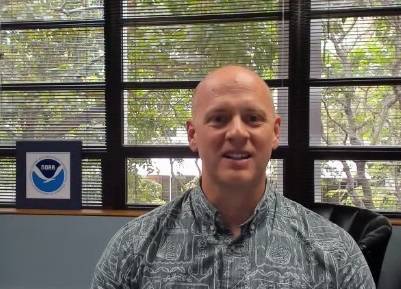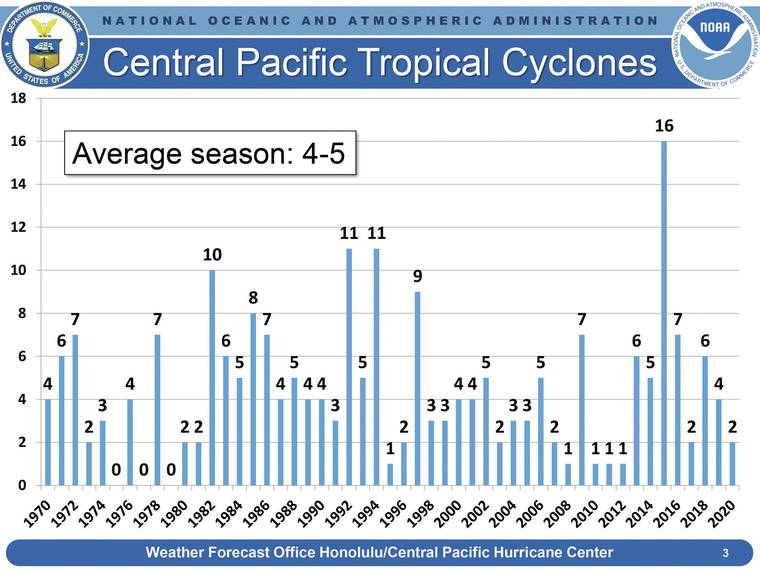Near- or below-normal hurricane season forecast for Central Pacific

This August 2018 image from the National Oceanic and Atmospheric Administration shows Hurricane Lane churning south of the Big Island.

IGE

BRENCHLEY

ROSENCRANS

The Central Pacific Hurricane Center on Wednesday predicted an 80% chance of a near- or below-normal hurricane season in the Central Pacific basin this year.
The Central Pacific Hurricane Center on Wednesday predicted an 80% chance of a near- or below-normal hurricane season in the Central Pacific basin this year.
Hurricane season in Hawaii runs from June 1-Nov. 30, and forecasters are predicting two to five tropical cyclones during the 2021 season. That includes tropical depressions, named tropical storms and hurricanes.
ADVERTISING
There are four or five tropical cyclones in a near-normal season. August and September are historically active months for storms in the region.
“This year, we will likely see less activity in the Central Pacific Region compared to more active seasons,” said Matthew Rosencrans, lead seasonal hurricane forecaster for the National Oceanic and Atmospheric Administration’s Climate Prediction Center in College Park, Md. “Less activity is predicted since ocean temperatures are likely to be near to below average in the central and eastern tropical Pacific Ocean where hurricanes form, and because El Nino is not present to increase the activity.”
The outlook, forecasters said, is a general guide to the overall seasonal tropical cyclone activity in the Central Pacific basin and doesn’t predict whether, or how many, of these systems will affect Hawaii.
Last year, only two tropical cyclones developed in the Central Pacific. Neither made direct landfall in Hawaii, but Hurricane Douglas swirled just offshore in July.
“Douglas threatened every county in the state of Hawaii, and it looked like one of those exercises that we go through in the worst case scenario,” said Gov. David Ige. “We were fortunate that the path changed, and it did not have that impact, but we must be prepared for what the new hurricane season brings to us.”
Officials encouraged people to prepare 14-day emergency kits that include food, water and other supplies.
“As we have experienced in previous hurricane seasons, it only takes one direct hit, or even a close call, to have a major impact on daily life here in the Hawaii Islands,” said Chris Brenchley, director of NOAA’s Central Pacific Hurricane Center.
“Take time to prepare now,” he said. “Make a preparedness plan so that you and your family stay healthy and safe.”
In 2018, the massive and powerful Hurricane Lane made a last-minute turn and narrowly spared Oahu, Hawaii’s most populous island.
The Big Island wasn’t so lucky.
Lane, the sixth hurricane of the busy 2018 hurricane season, didn’t technically make landfall in Hawaii. But throughout a four-day period between Aug. 22-26, East Hawaii was drenched by a deluge of historic proportions, and significant flash flooding occurred in multiple areas across northeast- and east-facing slopes of the island.
Mountain View received 51.53 inches of rain between noon Aug. 22 and 4 a.m. Aug. 26.
Hilo International Airport tallied 36.76 inches of rain for the four-day period between midnight Aug. 22 and 11:59 p.m. Aug. 26. That’s the wettest four-day period ever observed in Hilo, with records dating back to 1949.
Hilo also received 15 inches on Aug. 24, making it the fifth wettest calendar day on record.
Several evacuations occurred, with rescues taking place at Kaiulani Street on Reed’s Island in Hilo, as well as in Waipio Valley and Keaau Agricultural Lots subdivision.
Flooding from Lane was so extensive that on Aug. 24, three major highways were closed at one time, then-Managing Director Wil Okabe said. The flooding and debris left roads pot-marked and weakened in some places.
The last major hurricane to strike the state was Hurricane Iniki in 1992, a Category 5 storm that hit Kauai, causing six deaths and $3.2 billion in damage around the island.
Increased ocean and atmospheric temperatures caused by global warming could change hurricanes in Hawaii.
“Climate change has been positively linked to an increase in the number of category 4 and 5 storms,” Rosencrans said. “Climate change has also been linked to a 3% increase in the amount of rainfall from any given storm.”
According to Rosencrans, global warming has not been linked to the total number of hurricanes or tropical storms in a season.
The Associated Press contributed to this story.
Email John Burnett at jburnett@hawaiitribune-herald.com.


